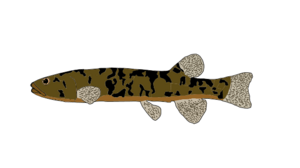Pedder galaxias facts for kids
Quick facts for kids Pedder galaxias |
|
|---|---|
 |
|
| Conservation status | |
| Scientific classification | |
| Genus: |
Galaxias
|
| Species: |
pedderensis
|
The Pedder galaxias (Galaxias pedderensis) is a small freshwater fish from Australia. It is sadly considered extinct in the wild since 2005. This means it no longer lives freely in nature. This special fish was originally found only in Lake Pedder in Tasmania.
Contents
Where They Live
The Pedder galaxias used to live only in Lake Pedder and the streams flowing into it. In 1972, a large dam was built. This created a "new" Lake Pedder. After this, the fish's home spread into Lake Gordon and the Wedge River.
However, by 1980, this fish became very rare. No Pedder galaxias have been found in the wild since 1996. Fish like introduced trout are a big reason why this species disappeared from its natural home.
Luckily, some Pedder galaxias still survive. They live in two special places outside their original home. One group is in Lake Oberon in the Western Arthurs mountains. The other group lives in a changed water dam near Strathgordon. These groups were moved there to keep the species alive.
What Do They Look Like?
The Pedder galaxias is a small fish. It is usually greenish-brown in color. Its belly is off-white or silvery. It has many irregular patterns of off-white and brownish bands. These bands go down its sides and even onto the base of its fins. On its lower sides, the bands break up into small spots. This fish can grow up to 160 millimeters long.
Home and Food
Before the new dam was built, the Pedder galaxias loved living in Lake Pedder. This lake was shallow and had white sandy beaches. It also had small plants growing in the water. The fish also lived in swamps and slow-moving waters. These areas had lots of natural debris and plants hanging over the water.
The Pedder galaxias eats small invertebrates. These are tiny creatures without backbones. They especially like arthropods and water insect larvae. They also eat crustaceans and land insects. Some of their favorite foods include beetles, flies, and cicadas.
Protecting the Pedder Galaxias
The Pedder galaxias is a very important fish to protect.
- It has been listed as "Extinct in the wild" by the EPBC Act since 2005. This means it no longer lives in its natural habitat.
- The IUCN has listed it as "Endangered" since 2019. This means it is at very high risk of becoming extinct in the future.
Life Cycle: How They Reproduce
Female Pedder galaxias fish are usually larger than the males. They lay their eggs in the spring, around October. This happens when the water temperature is between 6.7 and 7.5 °C.
A female fish can lay a lot of eggs, from 150 to 1,200. Each egg is quite small, about 1.9 to 2.3 millimeters wide after it has absorbed water.



